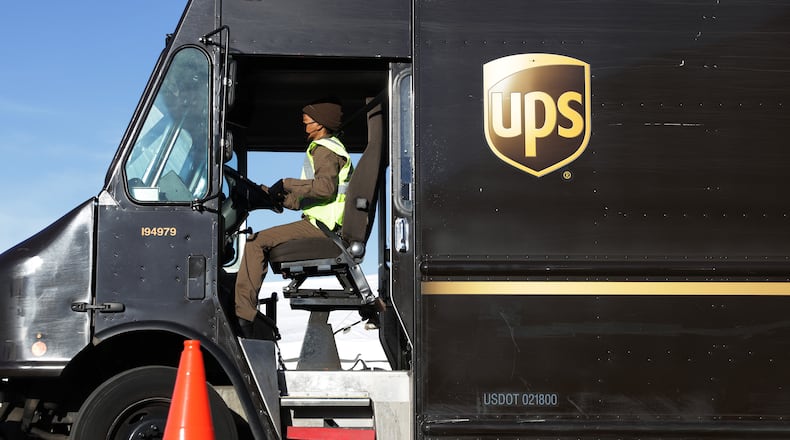Sandy Springs-based UPS has seen lower shipping volumes than last year, but higher shipping rates have driven strong revenue and profits for the company, despite the uncertain economic environment.
UPS chief financial officer Brian Newman said Tuesday there are “many cross-currents that contributed to a dynamic macro environment” in the last three months.
Internationally, “a softer macro economic environment, the war in Eastern Europe and lockdowns in China pressured volumes,” Newman said during a conference call with investors.
What’s happening with the economy in other parts of the world can also significantly affect consumers in the United States when ordering items manufactured overseas. Exports declined because of high global inflation and the COVID-19 lockdowns in Asia disrupted manufacturing output, Newman said.
In the United States, as inflation and higher interest rates drove up expenses for consumers, a strong job market has bolstered household spending. But consumers are shifting more of their spending from goods to services.
“We expected volume levels to decline from last year. They did, but more than we planned,” said UPS CEO Carol Tomé. “We remain focused on controlling what we can control. ... We’re not discounting as much.”
The company’s average revenue per piece — an indication of how much it costs to ship a package — was up 11.9% to $13.72 in the second quarter, compared with $12.26 a year ago.
That offset higher fuel costs and rising labor costs.
In the second quarter of the year, UPS reported $2.85 billion in net income, up from $2.68 billion a year ago. The company had $24.77 billion in revenue in the second quarter, up from $23.42 billion a year earlier.
In spite of lower expectations for growth of the U.S. economy in the second half of this year, UPS reaffirmed its target of $102 billion in consolidated revenue for this year, up from $97.29 billion last year.
One reason shipping volumes are down is that UPS reached an agreement with its largest customer, Amazon, that limits the volume of packages that UPS takes from Amazon. As a result, UPS expects Amazon to make up less than 11% of its revenue by the end of this year.
UPS was hoping to replace the lost Amazon volume with more profitable work from other companies. But some of that new business “hasn’t come into the network yet because we just won it,” Tomé said.
Labor costs are up in part because the company agreed to give its Teamsters workers a bigger raise this year, plus higher cost of living increases due to inflation.
Even though shipping volumes are down, UPS is not letting go of all of its excess workforce. The company wants to be prepared for a massive increase in online shopping expected for the holiday season later this year.
The company typically launches a major hiring effort in early September for 100,000 temporary workers to gear up its peak holiday shipping season.
“Knowing that we would need to hire for peak soon, we did not want to make a short-term decision that would negatively impact service later in the year,” Newman said. While the company is not paying hourly wages to those workers not needed to work now, it continues to provide them benefits, according to Tomé.
“We’re getting forecasts from all of our large customers now” for the peak holiday season, and “we expect it to be a good peak,” Tomé said. Inventory levels are better than last year and “retailers are planning to sell,” she said.
To offset increased wages and benefits, UPS is shifting more volume to automated facilities that need less manual handling of packages, and launching a new system for scheduling and driver dispatch. The UPS Teamsters contract is up for negotiation next year, and Tomé said UPS is “building contingency plans.”
The company, which announced last month the hiring of Bala Subramanian as its first chief digital and technology officer, is also turning to new ways of handling shipping orders.
It recently acquired a technology company called Delivery Solutions to allow retailers ship items from a store or distribution center, or offer store pickup or same-day delivery from providers including UPS-owned Roadie.
And UPS has piloted a system for orders from multiple retailers, to hold an order and match it with another order going to the same address. That helps to cut shipping costs, according to Tomé.
About the Author
Keep Reading
The Latest
Featured


